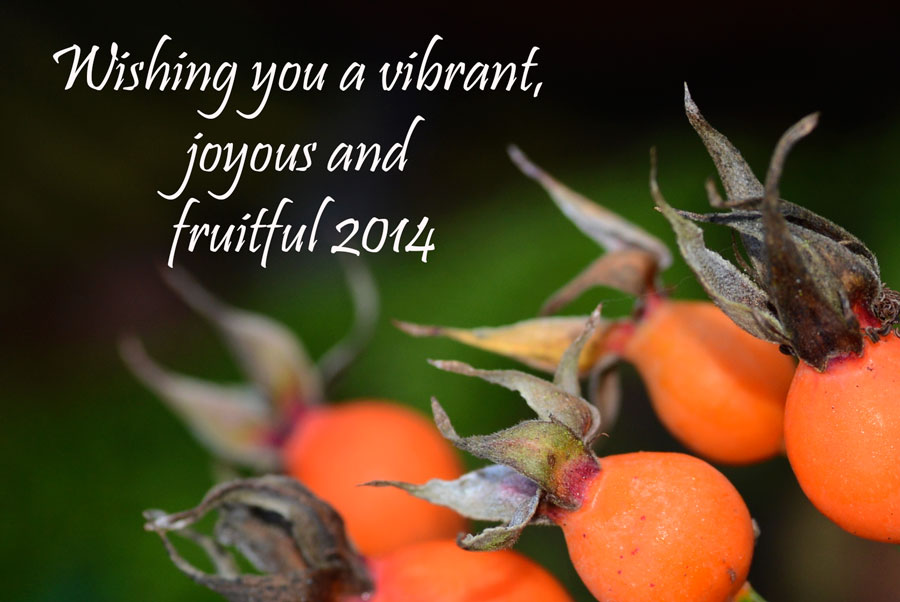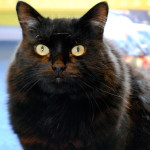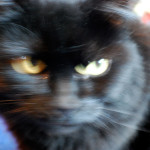Jinx
Jinx, daughter of Lucy and niece of Benson, has now left us after nearly 18 years. The shock and pain of her swift death have left us a little numb. She is the second of our beloved clan that we have lost this year which feels all the more unjust. Jinx was a quietly determined character, the ‘thinker’ of the group. There was many a time she would look me full in the face and seem to be weighing up what her next move would be, sometimes that look could only be described as disdain for the acts of humans.
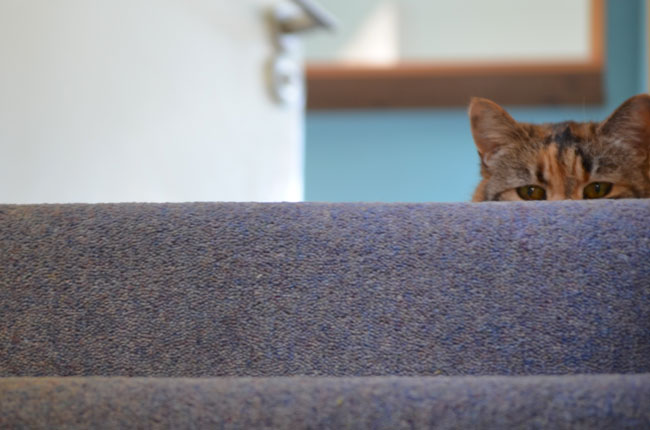
She generally chose to stay aloof and apart from the rest of the feline group and to be fair Phoebe and Lucy were often a little intolerant of her. Upstairs was her domain from the moment she was born in the bottom of my wardrobe. Lucy delighted us with four gorgeous kittens and the agreement was I could keep one and the others would find new homes. A friend took two, the wonderfully named Bonnie and Clyde, and we were left with Spike and a ‘spare cat.’ Somehow spare cat never moved out and she became my beautiful Jinx
She effectively made our bedroom and my office her main territory and woe betide any of the others straying in that direction. My expensive ergonomic office chair was essentially rendered useless as she loved nothing more than to wrap herself against its contours forcing me to perch on the edge, “push her off” I was frequently told, but that simply resulted in an on-going game of claiming and re-claiming the chair throughout the day – she was, as I have said, extremely determined when she set her mind to something.
She had a long, thin, striped tail a bit like a Lemur that would be held straight up Meerkat style as she ran to greet you or receive her food. It would also regularly beat a loud thumping contempt for whatever was irritating her. She was not an especially vocal cat and would occasionally chirrup for attention or to urge continued chin scratching. Generally she was more specific about what she wanted by poking me with a paw to gain attention, this became particularly painful when she chose it as her method for waking me up and I often received a scratched cheek or forehead.
As she got older she started to unleash what could only be described as a loud wail usually directed for no apparent reason toward the radiator. She would stop if you appeared or called to her and the vet suspected dementia, I now wonder if these weren’t earlier signs of the cancer taking its effect.
She really liked
Tuna
Raw white fish from the pet shop
The red cushion on the lounge chair
Sitting in the sun on the futon
Sleeping, sleeping, sleeping
Ear rubs and hugs
The luminous yellow toy mouse
She really disliked
Phoebe
Diet food
Other cats on ‘her’ bed
Being woken up unexpectedly
Benson being closer to me than she was
Sadly, much of the time, my partner – she seemed to take his nickname of the Prince of Darkness seriously and often eyed him suspiciously
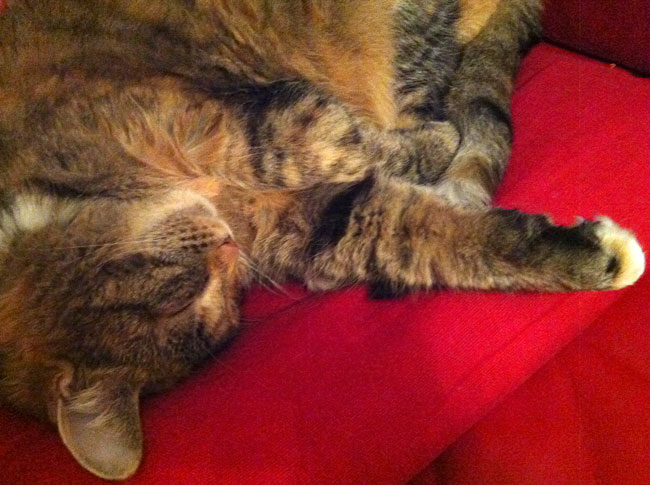
Writing about her life with us feels like an act of honouring and is undoubtedly a cathartic exercise; I am ignoring the voices that suggest she was ‘only’ a cat. For me she has been a wonderful companion of nearly 18 years and that leaves its own impression. I came across this piece from Henry Beston that sums up our intertwined nature, I think the concept of animals might be slowly changing and it seems to me that can only benefit humanity.
We need another and wiser and perhaps more mystical concept of animals. We patronise them for their incompleteness, for their tragic fate of having taken form so far below ourselves. And therein we err, and greatly err. For the animal shall not be measured by man. In a world older and more complex than ours they move finished and complete, gifted with extensions of the senses we have lost or never attained, living by voices we shall never hear. They are not brethren; they are not underlings; they are other nations, caught with ourselves in the net of life and time, fellow prisoners of the splendour and the travail ahead.
Whereas Phoebe (who I blogged about earlier in the year) taught me about courage, experimenting and testing the boundaries, Jinx reminded me of the need for quiet contemplation, of not acting in haste but devoting yourself completely once decided on a course of action. Her determination showed a true strength of character.
Thank you Jinx.
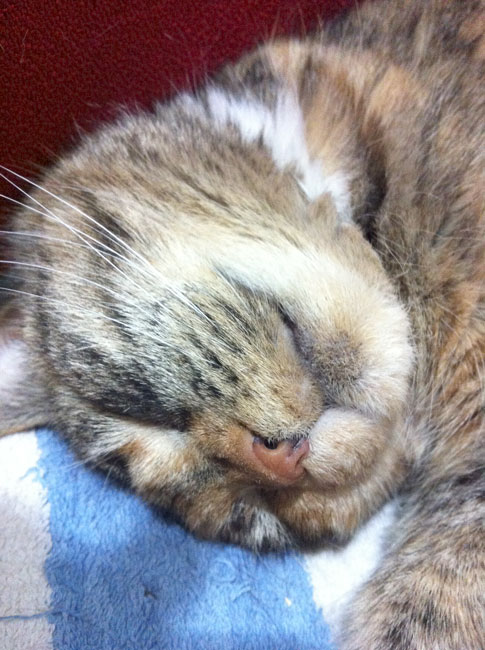
Deep peace of the running wave
to you
Deep peace of the flowing air
to you
Deep peace of the quiet earth
to you
Deep peace of the shining stars
to you
Deep peace of the infinite peace
to you
Adapted from Gaelic Runes
Jinx is survived by her uncle Benson (18 years) and her sister Spike (17 years)…and then there were two.
Recognition
…the act of recognizing; state of being recognized; acknowledgment; acknowledgment of status; a sign, token or indication of recognizing. Chambers 9th Dictionary
Have you ever experienced that warm glow of satisfaction as someone thanks you for a job well done? Or that fizzing irritation as something you said or contributed is ignored, or worse attributed to someone else? I recently spoke to someone who had won that month’s ‘Shining Light’ award given by her team for something she had achieved. From her smile and enthusiasm to tell me I could see it meant something to be recognised in this way.
Psychologically recognition is a powerful force rooted in the importance of our social relationships as part of our individual identity development. Donald Winnicott regarded recognition as the emotional response that makes our feelings, intentions and actions meaningful. Such recognition can only come from others whom we in turn value that is we recognise them and what they offer.
Charles Taylor seemed to sum up the importance of recognition when he said:
Recognition is not just a courtesy we owe people. It is a vital human need.
I see in my own coaching and development work the impact that a lack of recognition can have on people and the emotional turmoil this creates. It seems that out workplaces are not especially good at understanding the importance of recognition, despite the fact there is a wealth of research that demonstrates how valuable it is.
Research from human resources firm Bersin & Associates suggests that companies that excel at recognising their people are on average 12 times more likely than their peers to generate strong business results, including higher profitability and better market leadership positions. In addition, in organizations where recognition occurs, employee engagement, productivity and customer service are about 14 percent better than in companies that do not reward and recognize employees well. They also found that for ’employees, the most important elements of a recognition program are the ability to receive specific feedback and give recognition easily. This finding is underscored by the fact that the top reason employees do not recognize each other is because there is no established way to provide recognition.’
Research by Office Team suggests there are a number of things you need to get right to acknowledge the achievements of others:
- Get your facts straight – nothing is more embarrassing than incorrectly acknowledging a person’s name or individual accomplishment.
- Don’t offer token gestures – The form of recognition should fit the degree of achievement.
- Be specific – tie your acknowledgements back to specific actions so people know exactly what they did well.
- Don’t go overboard — recognition doesn’t need to be extravagant to be effective. Small, everyday things, such as saying “thank you” or giving credit for good ideas, can be powerful.
- Make sure you acknowledge everyone who was involved — although some people more naturally gravitate toward the limelight, don’t forget to celebrate unsung heroes who help behind the scenes.
Remember, whoever you are talking to also needs to value your recognition for it to make a difference!
The next time you do something that is acknowledged by someone else think about what it means to you.
References
Charles Taylor, (1992) ‘The Politics of Recognition’, in Amy Gutmann (ed.) Multiculturalism and ‘The Politics of Recognition’ Princeton: Princeton University Press, pp. 25-73;
Muddling Along
Muddling along
Give it our best shot
Keeping our fingers crossed
Flying by the seat of our pants
Testing the waters
Hoping for the best
Muddling through
How often in our work do we hear these expressions? While they may be said in jest there can be an underlying truth in terms of how people are facing particular challenges in their work. It would be unusual to see these terms in a business plan, they are certainly not associated with the language of rational strategy yet they are definitely part of our everyday experience.
This may in part be a reflection of the challenges of facing the white water referred to in the previous blog. Our business plans and goal statements try and smooth out the white water, they generally tell the stories of a cause and effect, linear world.
In his book ‘Learning as a Way of Being’ Vaill suggests that we find systems thinking too difficult to contemplate, we don’t want everything to be connected to everything else, we want these simple cause and effect chains so that we can take action and get results.
White Water
Above all, the problem with our existing model of learning is that it depicts learning as an institutional activity. This existing model has been overtaken by the rate of change in organisations and society…Permanent white water not only creates extraordinary learning challenges for us all, it also places enormous stress on the theories and forms of learning we practice to meet these challenges.
These wise words were written by the insightful Peter Vaill, a staggering 17 years ago in 1996. I’m ashamed to say I have only just come across his book – Learning as a Way of Being – and it seems to me it still has a lot to offer. Particularly, as the water feels to have got choppier than ever!
Start now
A touch of kindness
I was really struck by the story of Billy Ray Harris and his selfless return of a diamond engagement ring today. As someone who has also experienced a number of particular kindnesses this week my faith in the power of our capacity to care is renewed.
It also reminded me of some work I did a while ago about the importance of having hope in our lives.
A life well lived
Yesterday was not an easy one, we had to face that moment that all pet owners dread. Phoebe’s health had plummeted over the weekend and she was found to have an aggressive Pancreatic cancer. She was in terrible pain and very depressed so there was no choice in my mind, we had to say goodbye. I would not normally post such a personal blog but I have been thinking a lot about what she taught us and indeed what we might learn from her loss. It is also in some way comforting to capture her essence here and recognise all she brought us.
Her story
Phoebe was discovered amongst a bundle of other kittens in a local pet shop. She was a big, black, long-haired kitten, a bit like a four legged Tarantula! I was not in the shop to buy a kitten and passed the pen to pick up the food I needed. Half way past I felt a small tug at my jeans. I looked down and there was this little creature with paw fully outstretched through the cage bars grabbing at me. We were instantly connected, but I did not melt immediately, at that point we already had five other cats. I left the shop to discuss whether we could have yet another cat and my partner in his wisdom said he trusted me to do the right thing.
The next day Phoebe launched herself fearlessly into the midst of the five resident cats apparently completely oblivious as to why they might not welcome her arrival. The Princess had arrived. I was to learn later from my partner that this was not the decision he had trusted me to make!
She was a great chatterer and although you might not always get the complete gist of what was being communicated there was no question that some sort of message was being delivered, it was usually a matter of working through a set of possible alternatives. I think she knew Bateson’s levels of learning more intuitively than I did!
In her younger days she was an accomplished mouser and general bringer of gifts, even producing the head of a Pampass grass on one bizarre occasion. She was always a big cat and not the most agile or graceful of movers, but what she lacked in grace she more than made up for in strength and speed. My apologies go out to the budgerigar owner if the smattering of bright blue and green feathers I found one day in the dining room were not from a wild bird!
Over the last few years there is no doubt that life had slowed down for her, (she would have been 17 this year) she still adored lying in the sun on the deck or by the bamboo. Although she was never a lap cat, physical contact became increasingly important and she would demand it in no uncertain terms – stroking, brushing, just a general recognition of her presence. You were allowed to stroke or brush her until she deemed she had had enough and then she would find a favourite haunt, usually in the upturned cardboard lid from a printer paper box by the radiator. To say she was a snug fit would not quite describe the curious sight of her rolling over the top of it. We often joked about, ‘does my bum look big in this!’
Likes and dislikes
She really liked:
The sunshine and sitting in front of the bamboo
Roast chicken, pretty much fresh from the oven
Food generally, up until her Pancreas caused her problems
Being brushed
Sitting full length on the outstretched recliner chair
The lids of printer paper boxes
Tigger and the orange blanket on the futon
Chatting
She really disliked:
Darcey, the neighbour’s cat – he is a bit of a bruiser
Snow
Rain
Builders
Having her claws trimmed
Being in the basket to go to the vet
Flea treatment
Being ignored when she wanted something
One of our other cats being where she wanted to be
Learning from connections and loss
Her life taught us the value of stopping sometimes. Of seeing through different eyes and in doing so being able to reflect on Bateson’s question:
What pattern connects the crab to the lobster and the orchid to the primrose and all the four of them to me? And me to you?… what is the pattern which connects all the living creatures?
Gregory Bateson, (2002 Ed), Mind and Nature: A necessary unity.
Bateson tried to point out the shortcomings of the purposeful rational mind – for him dreams, religious experience, art and love were the phenomena that still had power. I believe Phoebe’s death teaches me to reconnect with my emotions, not those neatly managed emotions of the everyday, but the deep senses that remind me of my connectedness to a wider system. Such emotions that are often put aside as we dash from e-mail to text to meeting and back again.
It reminds me that control is an illusion and that loss is hard and creates a significant change in our lives. I remain convinced it is better to have those connections and learn from my sense of loss than not to have them for fear of the pain they might bring.
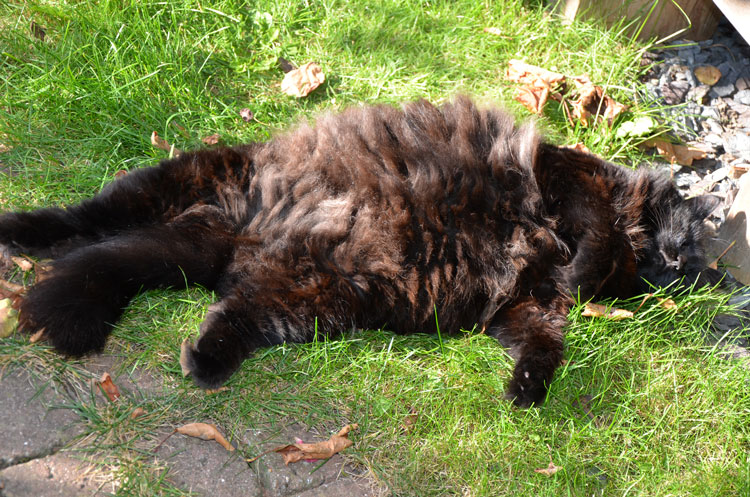

Phoebe is survived by Benson, Spike and Jinx who are 18, 17 and 17 respectively. She will leave a huge gap in the household but we know from experience that over time the raw pain fades and memories of this big character, who chose to live with us for so long, will make us smile again. We will come to know anew the things she connected us to.
A story of curiosity
One of the joys of spending time at the British Museum was seeing the many different objects and talking about their possible stories. We were asked to consider what their adventures were to get here and I was fascinated to hear how different the stories were that emerged.
Coincidentally, I was also recently given the Wellcome Collection’s ‘Guide for the incurably curious’ and in it the stories of the collection are beautifully illustrated.
Henry Wellcome liked to recall how, as a very young child, he had found what his father explained was an ancient stone arrowhead, and example of a technology more important to its makers than the telegraph and the steam engines of his day. That inspired his imagination – and it also taught him how to use an object to tell a story.
Thinking back to connections the thing that connected both the British Museum and the Wellcome Collection for me was this interest in the condition of mankind, something that allows the coming together of disciplines, cultures and timespans – something articulated through stories.
